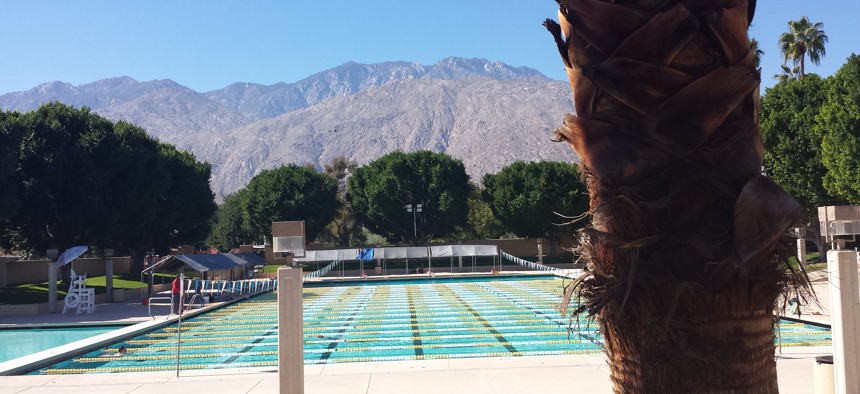Want to Save Water? Build a Municipal Pool

The Palm Springs Swim Center Michael Grass / GovExec.com

Connecting state and local government leaders
Places like Palm Springs, where there are countless private pools, are facing daunting water conservation challenges.
PALM SPRINGS, Calif. — As a largely man-made desert oasis that wouldn’t naturally exist, this city two hours east of Los Angeles has faced recent criticism for its excessive water use, including national attention from The New York Times, just as California Gov. Jerry Brown has handed down mandatory, statewide drought-driven water-use restrictions.
The resort town will undoubtedly watch lawns die and see grass and flowers traded for native desert landscaping in places to meet Brown’s 25 percent reduction directive.
And as water usage rises in the summer months—Palm Springs consumes more than twice as much water daily as the state’s average—the city is looking to guard another precious resource: its municipal pool.
“Community swimming pools are not only recreational, but serve for low impact exercise—such as lap swimming and water aerobics—and an educational opportunity such as swimming lessons,” said the city of Palm Springs’ chief of staff, James Thompson. “The Piranha Swim Team also hosts regular swimming competitions which bring in hundreds of families from out of the area.”
The Olympic-size swimming pool, open to residents and non-residents alike, has issued nearly 2,500 pool cards and is home to about 100 Piranha swimmers. High schools in Palm Springs and neighboring Cathedral City send 50 students each to the Palm Springs Swim Center daily.
A spring camp is offered at the pool, as are water exercise classes three times a week.
Beyond the recreational benefits, the municipal pool can serve as alternative for residents who have their own private, water-guzzling pools and may face an uncomfortable choice between refilling their pool and taking a shower or using a toilet.
But conservation is still a concern for the city’s aquatic center.
Palm Springs performed pool maintenance a few years ago looking for leaks, Thompson said, filling in minor cracks in the plaster and pool joints.
Spurred by Brown’s recent actions, the city will continue monitoring the pool for excessive leaks, preparing a capital improvement program to address them if needed, Thompson said.
Palm Springs’ parks and recreation director is also pricing pool covers and estimating the water savings that would come with reducing evaporation in the evening, when the pool is not in use, Thompson added.
Further east in the Coachella Valley, the city of Palm Desert’s rentable 8-acre Aquatic Center was built with efficiency in mind.
The center’s diatomaceous earth filtration system outperforms standard sand filtration and a roof-mounted solar array helps offset energy costs. Intelligent chemical monitoring constantly evaluates water quality to avoid the spiking associated with hand feeding, said Ryan Stendell, a senior management analyst with the city of Palm Desert.
The water quality system has a bypass mode that works like sleep mode on a computer, kicking in during the evening to reduce water consumption.
Families use the center year-round, Stendell said.
“We also believe that by offering this regional aquatic destination, the city is saving some of our residents the expense of building their own private pool and the resulting loss of water from it through evaporation,” Stendell said.
“We feel that this is a benefit when it comes to water use, especially when we are, as is currently the case, in a time of drought.”

NEXT STORY: How Quickly Did D.C.-Area Agencies and Utilities Relay Power Outage Info?





